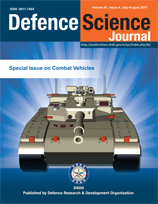Design Configuration of a Generation Next Main Battle Tank for Future Combat
Keywords:
Future combat, Threat scenario, Configuration, Firepower, Survivability, Mobility, Modularity, Adaptability
Abstract
The future combat scenario will undergo a sea change as compared to the conventional and un-conventional warfare employed by the traditional armies and non-state actors. In such a scenario, the main battle tank which serves as a game changer during these conflicts has to face the dilemma whether its design should be either evolutionary or revolutionary. To determine the basis of selecting the right type of design based on the above, the broad parameters that define the configuration namely number of crew, weight, armament system, survivability, operating range, transportability, tactical mobility, trafficability, intelligence - surveillance - target acquisition - reconnaissance (ISTAR), system modularity and theatre of operation have been considered. Taking these parameters into account, this study evaluates both the evolutionary and revolutionary design configurations for a generation next main battle tank. Finally, from the outcome of this study it is observed that the revolutionary design approach not only fares better compared to the evolutionary approach, but also possess ease of adaptiveness as an universal combat weapon platform.
Published
2017-06-30
How to Cite
Rahman, A., Malik, A., Kumar, J., Balaguru, V., & Sivakumar, P. (2017). Design Configuration of a Generation Next Main Battle Tank for Future Combat. Defence Science Journal, 67(4), 343-353. https://doi.org/10.14429/dsj.67.11426
Section
Special Issue Papers
Copyright (c) 2017 Defence Science Journal
 Where otherwise noted, the Articles on this site are licensed under Creative Commons License: CC Attribution-Noncommercial-No Derivative Works 2.5 India
Where otherwise noted, the Articles on this site are licensed under Creative Commons License: CC Attribution-Noncommercial-No Derivative Works 2.5 India

